Main varieties
Growing a peony is not too burdensome, even for an experienced grower. However, you should study the description of the key characteristics of the varieties of this plant. In this case, you will appreciate all the variety of this category, and also choose the species you like the most for planting.
Bowl of Cream
Among the lactic-flowered peonies, it is worth highlighting the Bowl of Cream variety. It is a herbaceous plant with double inflorescences. The petals are creamy. Several buds are formed on the peduncle, but if you want to form them large, it is better to leave only the central ones on the stem. This floral specimen develops elongated leaves of a dark green hue. It is recommended to root it in well-lit areas of the garden.
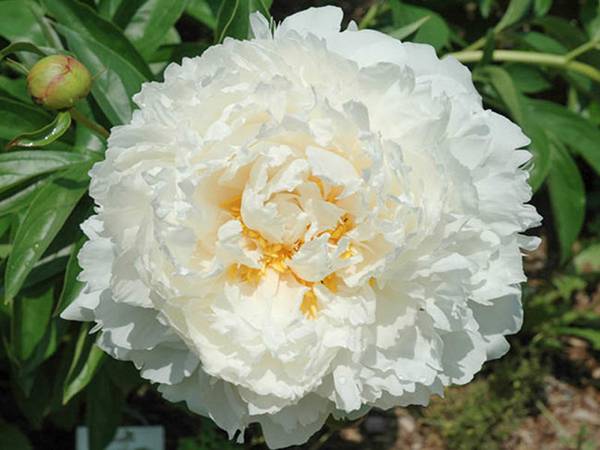
Lady Alexandra Duff
The variety called Lady Alexandra Duff is notable for its semi-globular buds of a delicate powdery shade. The dark green leaves of the plant contrast perfectly with them. It is not difficult to care for such a shrub, and the result will satisfy even the most demanding grower. The thing is that the peony grows very intensively, and 4–5 years after its rooting on one bush, up to 100 buds can form during the flowering period.
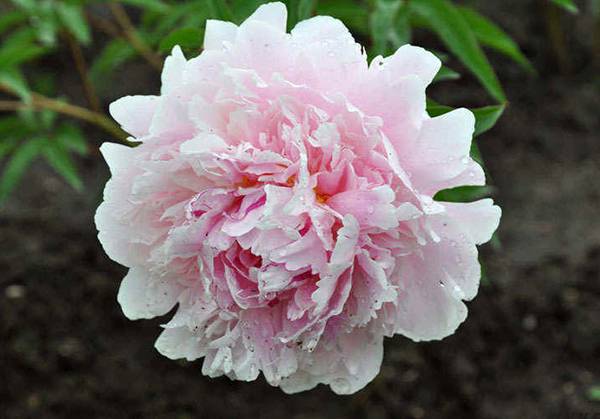
Miss America
Among the popular peony varieties, Miss America is also worth highlighting. Its flowers are quite large, their diameter is about 25 cm. The petals of the peony are white, and the core has a yellow tint. The shrub reaches a height of no more than 80 cm. What is good about this variety of milk-flowered peony is that its flowering phase is rather long.
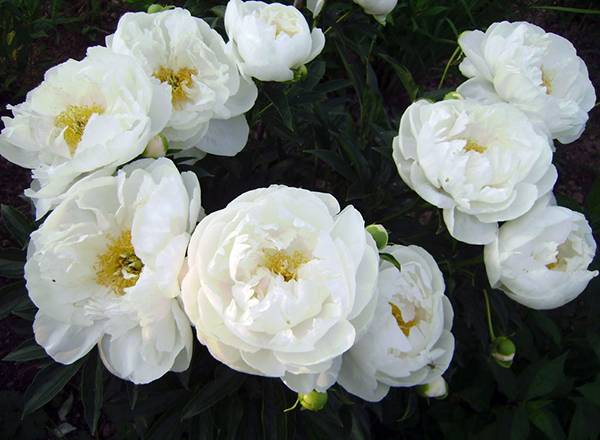
Carol
A variety called Carol stands out for its reddish-pink lush buds. The diameter of the flower is about 13-16 cm. The shrub reaches a height of about 80-90 cm. Do not forget about the insignificant nuance of this variety: its stems are not too strong, so you cannot do without support.

Class Act
Hybrid Class Act refers to double flowers, its buds are pink. The flowering period of this peony variety is average. The inflorescences exude a delicate, pleasant aroma. The shrub is quite compact, its height is about 90 cm.

Elsa Sass
Among the varieties with large double flowers, it is worth highlighting a variety of milk-flowered peony called Elsa Sass. The buds of this plant are distinguished by a delicate aroma and have yellow stamens. If you want to grow a peony for a cut, you can safely give preference to this variety.
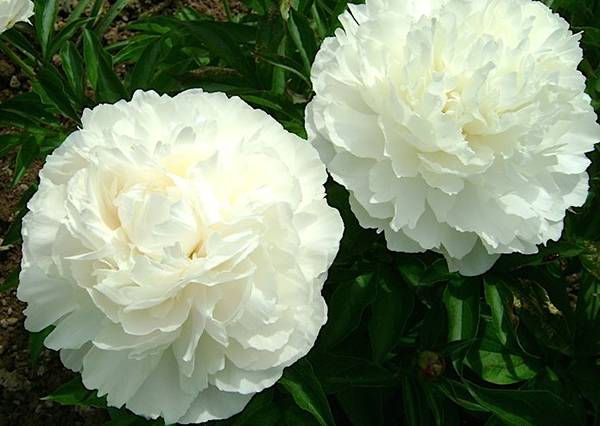
Honey Gould
The diameter of the flower is about 18 cm, and the height of the shrub is no more than 90 cm. Honey Gould is a double crown plant, the shade shimmers from white to warm yellow (from the edge of the petals to the core).
The leaves of this compact shrub have a rich green tint, covered with a slight sheen. This plant is fragrant and has an average flowering period.
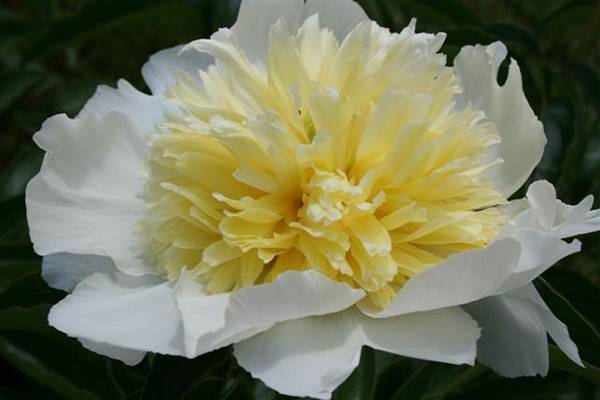
Buckeye Bell
The Bakai Bell peony variety is distinguished by beautiful semi-double buds with a dark brown or even burgundy hue. In the heart of the flower, yellow stamens are present. Such a plant blooms for about two weeks. The shrub is decorative, therefore it is often used in landscape design. In leaving, he is picky.
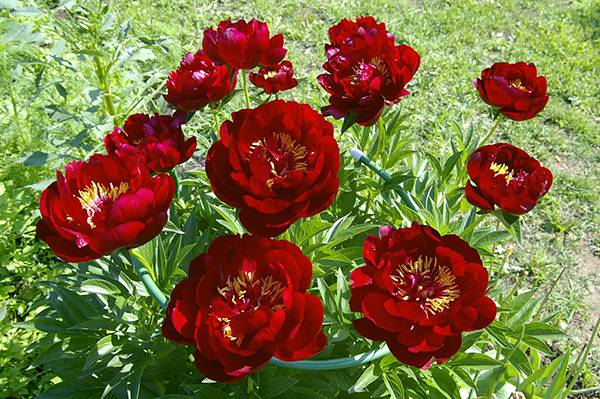
Nippon Beauty
The peony variety Nippon Beauty has pink-red flowers. This plant can be rooted both in a well-lit area and in a shaded area. This floral specimen is a worthy choice for a domestic grower, since it will tolerate severe frosts without any special difficulties. The shrub is spreading and reaches a height of about 80–90 cm.

Marie Lemoine
The peony variety Marie Lemoine during the flowering period is covered with double crown buds of a pale white hue. Such a specimen has a mild aroma, and it blooms late. This plant has good resistance to low temperatures.
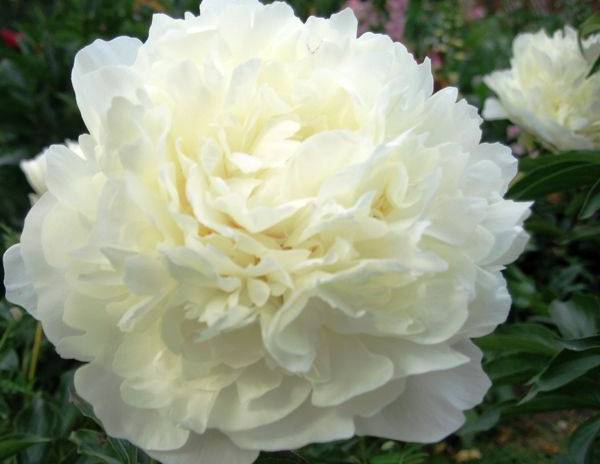
Top Brass
What is especially remarkable for the Top Brass peony variety is its large buds with white petals, the diameter of which is about 20 cm. The shrub reaches a height of 1 m. The plant blooms once, but abundantly. It can be planted in open areas or in partial shade. This floral specimen has good winter hardiness - this is one of its key advantages.
Description of peonies "Lorelei" and the rules of their cultivation
Peonies are one of the most common plants in the front garden. They are easy to care for, the shrubs grow wide, bloom profusely for several months and delight with a wide palette of shades thanks to the painstaking work of breeders. Among the varieties loved by domestic plant breeders, "Lorelei" is especially distinguished.
Characteristic
This herbaceous interspecific hybrid exhibits bright, voluminous flowers of an orange-pink hue. The buds have a diamond shape, they are densely double. If you plant a bush in the sun, and not in partial shade, as experts recommend, then the color loses its brightness, since the petals fade in the sun and can become a peach hue. According to the description proposed by the breeders, there are no lateral buds during the formation of the peduncle, the diameter of the flower is 14 cm, with a height of the bush of 65 cm. The aroma of the peony emits light, to feel it, the flower will need to be brought close to the face.
The described species does not apply to early flowering. The bushes are low, the stems are strong, therefore, even with abundant flowering, no support is needed. The foliage is green, in a standard peony shape.
Landing
A peony requires little maintenance as long as it is planted in the right place. These flowers respond very poorly to transplantation, so you should not resort to the procedure if there is no particular need for it.
In most of the country, peonies are planted in autumn: at the end of September and in October, and a little later in the south. Peonies will need to be immersed in the ground six weeks before the first frost, this is how much is needed for the plant to take root. The bushes planted in the spring lag behind in growth by about a year from those planted in the fall.
The soil should be fertile, rich in humus, moist but well-drained. The ideal pH is neutral. The plant needs to provide shelter from strong winds. Plant it away from trees or large shrubs, since peonies do not like to compete for nutrients and moisture.
To plant the tuber, you need a hole 60 cm deep and wide. It is best to add organic material to the bottom, which will serve as top dressing for several years. If the soil is heavy or very sandy, it is additionally enriched with compost. The tuber is immersed in a hole to a depth of 5 centimeters, then covered with soil. It will need to be lightly tamped, thus removing air pockets. After planting, high-quality watering is performed.
It is not difficult to take care of the plant, it usually takes several years for peonies to take root at the planting site. Unlike most perennials, they do not need to be dug up and separated for high-quality flowering. Let's take a look at some tips for caring for these plants.
- Fertilizer should be applied long before the peony is planted in the ground. If the soil is poor, then bone meal, compost or well-rotted manure, which are poured into the soil in early summer, after the peonies have faded, will be the best feeding. Do not fertilize more often than once every few years.
- Sometimes the stems are not strong enough to support giant flowers. In this case, additional supports can be provided.
- Before wintering, the plant is cut to the root.Such pruning is a high-quality prevention of many diseases.
- Neem oil and a solution of insecticidal soap can help fight aphids and other insects. Fungicides work best for fungal infections. Bacterial infections are not cured, but you can try to cure the flower if you orient yourself in time and remove damaged shoots.
- The peony is not watered too often, the main thing is that the soil remains moderately moist. On hot days, you can preserve moisture with the help of mulch laid around the plant. In regions where winters are cold, in the first winter after planting, you can mulch the soil with needles or crushed bark. Remove the mulch in the spring.
Peony Mlokosevich - how to grow in the middle lane
Since its discovery, this peony has become the object of interest of many botanical gardens and private collections in Europe and America. A rare flower with an unusual "moon-yellow" shade of petals that did not fade by the end of the season was discharged from his homeland in such quantities that they seriously discussed giving the plant a protected status in order to prevent the complete destruction of the natural population. In 1912, the Lagodekhi region with all its flora and fauna really became a nature reserve.
Today this plant is a rather exotic guest of our flower beds, rather it can be found in the collections of real connoisseurs of peonies, although the seeds, with due diligence, can be found on sale. But not everyone succeeds in raising a capricious mountain dweller. Why?
In the middle latitudes, he does not really like the climate, it is too dry and hot - so if you want to settle him on your own plot, you will have to try to "bring" the living conditions closer to the habitual conditions for this flower (see above).
Mlokosevich's peony is shade-loving and cold-resistant, although it appreciates rather warm and humid conditions - as a "gratitude" to a caring peony breeder, it will delight with an abundance of flowers on one bush, although in nature it saves energy and prefers to release single flowers.
The best way breeding this peony for preservation of its species properties - by seeds, although a vegetative way is also possible.
The soil for this plant is not suitable for the most fertile, but always water and air permeable. Forget about heavy fatty black soil, make a light mixture of deciduous humus, sand and gravel (2: 1: 1), so the Mlokosevich peony will feel “at home”.
As we have already said, the seeds of this peony ripen in July-August, and the best time for sowing them is September-October, although it is possible to do this in spring. With spring sowing, Mlokosevich's peony will rise only after a year, with autumn sowing already next spring (although sometimes they also "linger" until the next season). Flowering in our latitudes should be expected at about the 5th year of life.
If you chose the first option (autumn sowing), then after harvesting, the seeds can be immediately placed in individual containers with prepared soil and dug in the garden, watering from time to time, and covered with a thick layer of litter for the winter.
It is very important to collect ripe, but not over- or unripe seeds of this peony, otherwise it will be very difficult for them to germinate
In the case of the second option, when you want to preserve the seeds of the Mlokosevich peony until spring, for guaranteed germination, you will have to subject them to gradual stratification - first warm and then cold. So, again, natural conditions are imitated, when the crumbling peony seeds overwinter in a kind of "greenhouse" in leaf litter, and then they are wrapped in snow.
3 best ways to stratify seeds
If you want to become an expert in growing flowers and conifers from seeds, master the procedure of stratification.
In any case, the seeds of the Mlokosevich peony are not deeply embedded (a depth of 1-2 cm is enough), the seedlings must be shaded and strictly monitored the timely moisture of the soil.Many people prefer to plant plants in individual pots, which are then buried in the ground - it is more convenient to monitor the state of young peonies, so that then, when they really get stronger, plant them on a permanent place of "residence" in the garden.
As for the further care of adult bushes, it is similar to that for all other types of herbaceous peonies: use fertilizers sparingly, water and loosen on time, remove weeds and damaged parts of plants, do not forget about the prevention of diseases and pest infestations, cut the bushes briefly for the winter ...
Peonies - planting and care, all work by month
Caring for peonies - when and what to do to make peonies bloom luxuriantly.
If we talk about possible diseases, then the "savage" peony of Mlokosevich is very resistant to most of them. An exception, as for all yellow-flowered plants, is such an unpleasant ailment as gray rot - when any aerial parts of the plant, due to the pathogenic fungus, begin to fade and become covered with a gray bloom
The pathogen especially likes humid weather and shaded areas, so it is important not to overdo it with watering and prevent plantings from thickening. Already infected plants can be saved with modern specialized fungicides, for example, Skor, Teldor, Alirin-B, Maxim, etc.
Diseases and pests of peonies: photo, description and treatment
What diseases and pests are most afraid of peonies and how to protect these plants from the main misfortunes?


